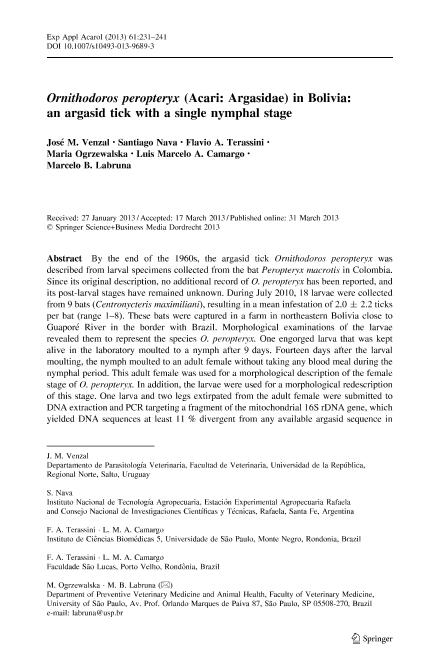Mostrar el registro sencillo del ítem
dc.contributor.author
Venzal, José M.
dc.contributor.author
Nava, Santiago

dc.contributor.author
Terassini, Flavio A.
dc.contributor.author
Ogrzewalska, Maria
dc.contributor.author
Camargo, Luis Marcelo A.
dc.contributor.author
Labruna, Marcelo B.
dc.date.available
2016-07-12T20:15:00Z
dc.date.issued
2013-09
dc.identifier.citation
Venzal, José M.; Nava, Santiago; Terassini, Flavio A.; Ogrzewalska, Maria; Camargo, Luis Marcelo A.; et al.; Ornithodoros peropteryx (Acari: Argasidae) in Bolivia: an argasid tick with a single nymphal stage; Springer; Experimental And Applied Acarology; 61; 2; 9-2013; 231-241
dc.identifier.issn
0168-8162
dc.identifier.uri
http://hdl.handle.net/11336/6468
dc.description.abstract
By the end of the 1960s, the argasid tick Ornithodoros peropteryx was described from larval specimens collected from the bat Peropteryx macrotis in Colombia. Since its original description, no additional record of O. peropteryx has been reported, and its post-larval stages have remained unknown. During July 2010, 18 larvae were collected from 9 bats (Centronycteris maximiliani), resulting in a mean infestation of 2.0 ± 2.2 ticks per bat (range 1–8). These bats were captured in a farm in northeastern Bolivia close to Guaporé River in the border with Brazil. Morphological examinations of the larvae revealed them to represent the species O. peropteryx. One engorged larva that was kept alive in the laboratory moulted to a nymph after 9 days. Fourteen days after the larval moulting, the nymph moulted to an adult female without taking any blood meal during the nymphal period. This adult female was used for a morphological description of the female stage of O. peropteryx. In addition, the larvae were used for a morphological redescription of this stage. One larva and two legs extirpated from the adult female were submitted to DNA extraction and PCR targeting a fragment of the mitochondrial 16S rDNA gene, which yielded DNA sequences at least 11 % divergent from any available argasid sequence in Genbank. We show that O. peropteryx ontogeny is characterized by a single, non-feeding, nymphal stage. This condition has never been reported for ticks.
dc.format
application/pdf
dc.language.iso
eng
dc.publisher
Springer

dc.rights
info:eu-repo/semantics/openAccess
dc.rights.uri
https://creativecommons.org/licenses/by-nc-sa/2.5/ar/
dc.subject
Ornithodoros
dc.subject
Bolivia
dc.subject
Biology
dc.subject.classification
Ciencias Veterinarias

dc.subject.classification
Ciencias Veterinarias

dc.subject.classification
CIENCIAS AGRÍCOLAS

dc.title
Ornithodoros peropteryx (Acari: Argasidae) in Bolivia: an argasid tick with a single nymphal stage
dc.type
info:eu-repo/semantics/article
dc.type
info:ar-repo/semantics/artículo
dc.type
info:eu-repo/semantics/publishedVersion
dc.date.updated
2016-07-06T15:46:15Z
dc.journal.volume
61
dc.journal.number
2
dc.journal.pagination
231-241
dc.journal.pais
Alemania

dc.journal.ciudad
Berlin
dc.description.fil
Fil: Venzal, José M.. Universidad de la República. Facultad de Veterinaria. Departamento de Parasitología Veterinaria; Uruguay
dc.description.fil
Fil: Nava, Santiago. Instituto Nacional de Tecnologia Agropecuaria. Centro Regional Santa Fe. Estacion Experimental Agropecuaria Rafaela; Argentina. Consejo Nacional de Investigaciones Científicas y Técnicas. Centro Científico Tecnológico Santa Fe; Argentina
dc.description.fil
Fil: Terassini, Flavio A.. Universidade de São Paulo. Instituto de Ciências Biomédicas; Brasil
dc.description.fil
Fil: Ogrzewalska, Maria. Universidade de São Paulo. Faculdade de Medicina Veterinária. Departamento de Medicina Veterinária Preventiva e Saúde Animal; Brasil
dc.description.fil
Fil: Camargo, Luis Marcelo A.. Universidade de São Paulo. Instituto de Ciências Biomédicas; Brasil
dc.description.fil
Fil: Labruna, Marcelo B.. Universidade de São Paulo. Faculdade de Medicina Veterinária. Departamento de Medicina Veterinária Preventiva e Saúde Animal; Brasil
dc.journal.title
Experimental And Applied Acarology

dc.relation.alternativeid
info:eu-repo/semantics/altIdentifier/url/http://link.springer.com/article/10.1007/s10493-013-9689-3
dc.relation.alternativeid
info:eu-repo/semantics/altIdentifier/doi/http://dx.doi.org/10.1007/s10493-013-9689-3
dc.relation.alternativeid
info:eu-repo/semantics/altIdentifier/doi/10.1007/s10493-013-9689-3
Archivos asociados
